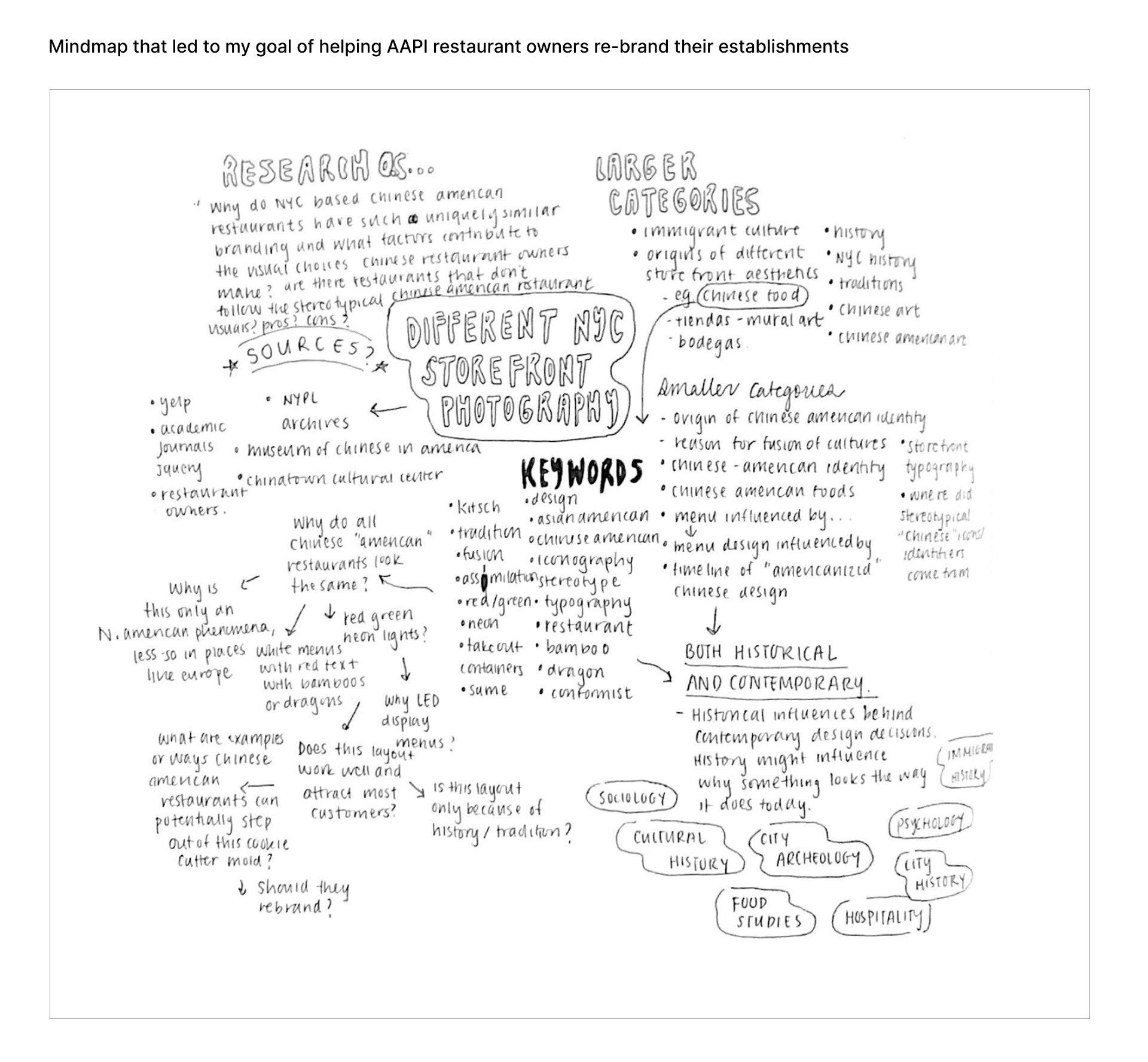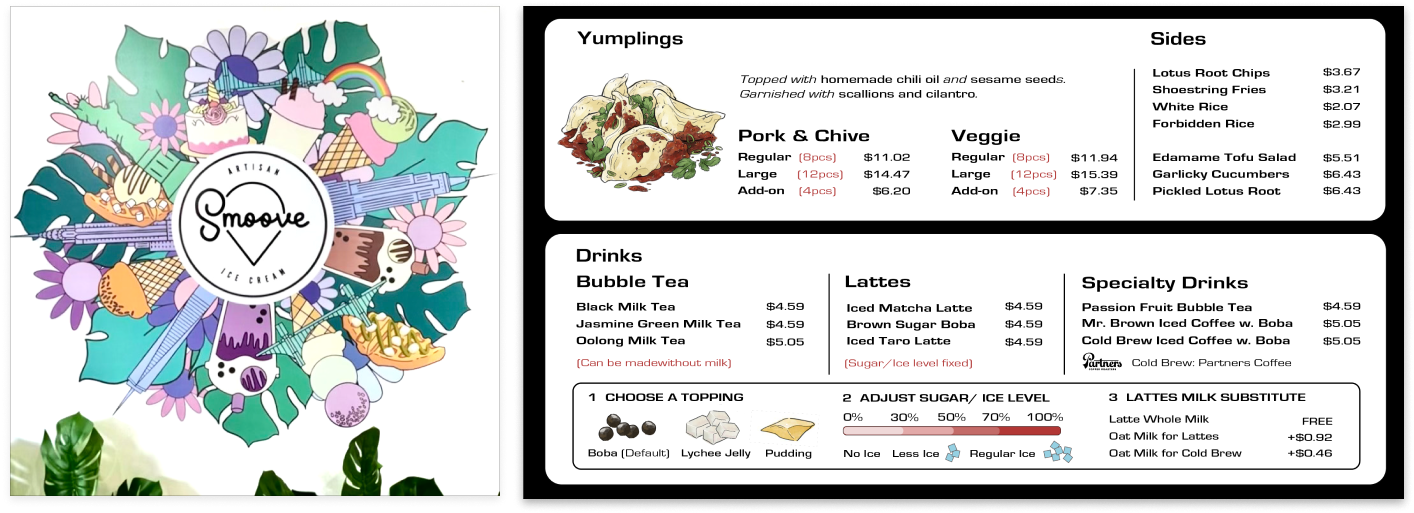Helping AAPI–owned restaurants establish authentic, modern visual identities that pay homage to Asian culture and history.
![]()
Timeline: May 2021 – December 2021
Tools: Adobe Illustrator, Photoshop, Figma, Procreate
Skills: Competitive analysis -> brand positioning -> brand identity design
After opening my own small business hand-crafting trinkets inspired by my cultural heritage, I started to wonder...
1. Where did the “stereotypical” Asian American visual identity centered around dragons and pagodas come from?
2. How were decorative motifs often associated with Chinese and other Asian American businesses established?
3. Do these existing visual patterns pay homage to Asian American culture?
4. If not, how can I use design to help raise awareness of authentic Asian motifs?
![]()
Historical research and findings
![]()
After conducting in-depth research on the Chinese American restaurant branding phenomenon for three months, I found that Chinese American food has been perpetuated to a distinctive stereotype in the last century, due to the stigmatization of Chinese immigrants and the need for a distinctive brand identity in order to appeal to Western audiences.
The Chinese Exclusion Act and anti-Chinese sentiments caused many Americans to adopt negative stereotypes towards the Chinese, deeming them as perverts and opium addicts. Thus, it was difficult for the young generation of Chinese Americans to find employment in a society that deemed them second-class citizens.
The increase of Chinese American restaurants in the United States is attributed to a loophole in American immigration law, and the depiction of Chinese being “exotic” and “oriental” led to the hybridization of traditional Chinese culture with Western cultures, creating a hybridized restaurant aesthetic that remains to this day.
Helping small businesses in Manhattan’s Chinatown
I developed visual identities for AAPI–owned restaurants and conducted brand positioning research and analysis, and created moodboards, illustrations, and digital prototypes. This resulted in more authentic, modern brands that pay homage to Asian culture and history. No more stereotypical pagodas and dragon motifs!
I helped branded Smoove, a newly opened Chinatown fusion ice cream parlor. Established brand guidelines, designed a stationary set, digital and analog menus, promotional posters, social media content, and a vinyl wall graphic.
I assisted in creating graphics for Yumpling Taiwanese Cafe in Long Island City, NY, as well as various condiment brands in partnership with Overice Studio.
![]()
![]()
![]()

Timeline: May 2021 – December 2021
Tools: Adobe Illustrator, Photoshop, Figma, Procreate
Skills: Competitive analysis -> brand positioning -> brand identity design
After opening my own small business hand-crafting trinkets inspired by my cultural heritage, I started to wonder...
1. Where did the “stereotypical” Asian American visual identity centered around dragons and pagodas come from?
2. How were decorative motifs often associated with Chinese and other Asian American businesses established?
3. Do these existing visual patterns pay homage to Asian American culture?
4. If not, how can I use design to help raise awareness of authentic Asian motifs?

Historical research and findings

After conducting in-depth research on the Chinese American restaurant branding phenomenon for three months, I found that Chinese American food has been perpetuated to a distinctive stereotype in the last century, due to the stigmatization of Chinese immigrants and the need for a distinctive brand identity in order to appeal to Western audiences.
The Chinese Exclusion Act and anti-Chinese sentiments caused many Americans to adopt negative stereotypes towards the Chinese, deeming them as perverts and opium addicts. Thus, it was difficult for the young generation of Chinese Americans to find employment in a society that deemed them second-class citizens.
The increase of Chinese American restaurants in the United States is attributed to a loophole in American immigration law, and the depiction of Chinese being “exotic” and “oriental” led to the hybridization of traditional Chinese culture with Western cultures, creating a hybridized restaurant aesthetic that remains to this day.
Helping small businesses in Manhattan’s Chinatown
I developed visual identities for AAPI–owned restaurants and conducted brand positioning research and analysis, and created moodboards, illustrations, and digital prototypes. This resulted in more authentic, modern brands that pay homage to Asian culture and history. No more stereotypical pagodas and dragon motifs!
I helped branded Smoove, a newly opened Chinatown fusion ice cream parlor. Established brand guidelines, designed a stationary set, digital and analog menus, promotional posters, social media content, and a vinyl wall graphic.
I assisted in creating graphics for Yumpling Taiwanese Cafe in Long Island City, NY, as well as various condiment brands in partnership with Overice Studio.



With the increase of globalization, however, the visual culture around Chinese American restaurant branding is quickly adapting and changing from its second-class status to cuisine with an elevated place in American culture as a whole.
Albeit steady progress in relations to the status of Asian Americans, current events taking place in 2021 have shown that there is still much stigmatization towards the Asian community and that even if not immediately apparent, visual culture can impact an individual’s perception of the world around them.
Before taking visual culture for granted, including the stereotypical branding of Chinese American restaurants, however, individuals should analyze and interpret for themselves the origin of such visual concepts, and the historical implications of these concepts.
Albeit steady progress in relations to the status of Asian Americans, current events taking place in 2021 have shown that there is still much stigmatization towards the Asian community and that even if not immediately apparent, visual culture can impact an individual’s perception of the world around them.
Before taking visual culture for granted, including the stereotypical branding of Chinese American restaurants, however, individuals should analyze and interpret for themselves the origin of such visual concepts, and the historical implications of these concepts.